 Facebook
Facebook
 X
X
 Instagram
Instagram
 TikTok
TikTok
 Youtube
Youtube
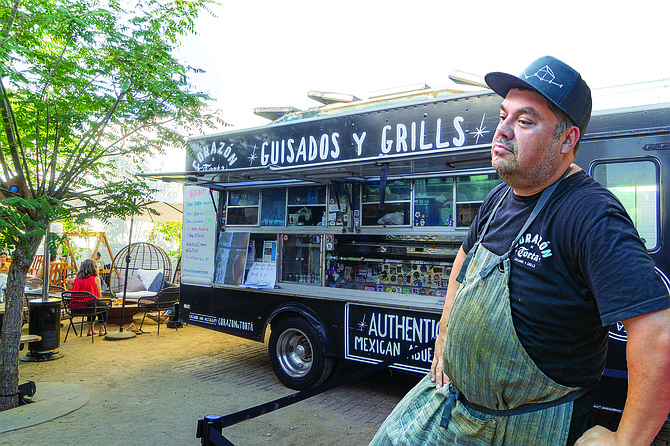
“I’m doing this guerrilla-style!” shouts Antonio Ley, also known as El Tony Tee, as I approach his taco truck. “We got kicked out because of the stupid bike lane last week, and I have to park here for now.” The stupid bike lane in question runs along 30th Street as it cuts through North Park, and its installation in February of 2022 cost the street nearly 400 parking spaces, including the one right in front of Fall Brewing, where Tony liked to park his taco truck, Corazón de Torta. So now he’s set up in a nearby residential spot. “The cop told me to move anywhere, just as long as I didn’t block the bike lane. And I know the girl who lives here. She’s celebrating her birthday in Valle de Guadalupe. I keep texting her, but no answer.” (Eventually, the brewery will have to sacrifice some patio space to accommodate visiting food trucks.)
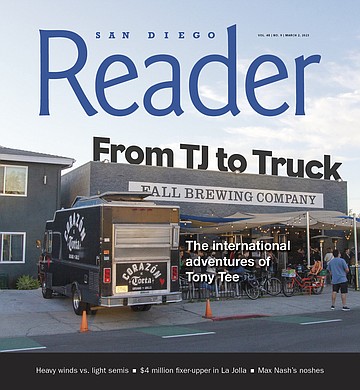
I’m here because I work in Tony’s truck from time to time. He calls me whenever his main cook is on vacation, or when he is in between workers. If I’m not available, he has several friends in rotation. Sometimes, he ends up asking a family member to cover for him. But I try to be available.
When I work the truck, I do a bit of everything — from cleaning, to making salsa, to prep work, to cooking, to photographing the food for marketing purposes. Mostly, I man the cash register and take tacos to the customers. But even though I am the one in the window taking orders, most of the customers want to talk to Tony — and he is eager to talk back. Tony Tee is vociferous, and a natural entertainer, happy to talk to everyone and no one about everything and nothing. Today, he will tell every customer that same story about the stupid bike lane, asking if they are for or against the lane, and how many bikes they’ve seen go by. A while back, he told everyone that he had gotten tickets to the Bad Bunny concert. Why wouldn’t they want to know?
I’ve known Tony for nine years, but I knew of him years before that. Part of Tony’s celebrity is the sort that comes when you bump up against a superstar and get a little stardust rubbed off on yourself: when chef-turned-author-turned-food-adventurer Anthony Bourdain visited Tijuana in January 2012, Tony acted as one of his tour guides. “I didn’t know I was going to tour him until a few hours before!” says Tony when I ask him about it. “Yeah, people give me shit because of the places I took him, but I had no time to properly prepare.”
Bourdain visited Tijuana for Episode 9 of Season 8 of his Travel Channel show No Reservations. It aired on May 27, 2012. The episode started with Bourdain crossing the border and eating a basic torta at one of the stands near the old San Ysidro gateway. That was followed by a Baja-Med style meal of sous vide beef tongue served by Javier Plascencia in one of his restaurants, Mision 19. The restaurant celebrated its 12 anniversary in January 2023 — it was only a year old when Bourdain visited. Bourdain seemed delighted with every plate he sampled.
Later in the episode, Tony and Bourdain met on Calle Sexta near Avenida Revolución to check out Dandy del Sur. “Tijuana grew up as a reaction to Prohibition,” said Bourdain. “When you couldn’t get a drink in California, Americans came here, wanting gambling, horse racing, and hookers, along with their cocktails.”
Added Tony, “What Tijuana is slowly starting to realize is that the old concept of tourism here, a $10 all-you-can-drink, nasty bar full of Marines, is not going to fly anymore,” He took a drink from his beer and continued: “[Tijuana]is in its beginning phases of re-inventing itself. There’s avant-garde restaurants over here now; there’s tiny little dive bars. It’s not for the tourist, the Yankee gringo tourist we are all used to. It’s for the locals. It’s all local kids, having a great time.”
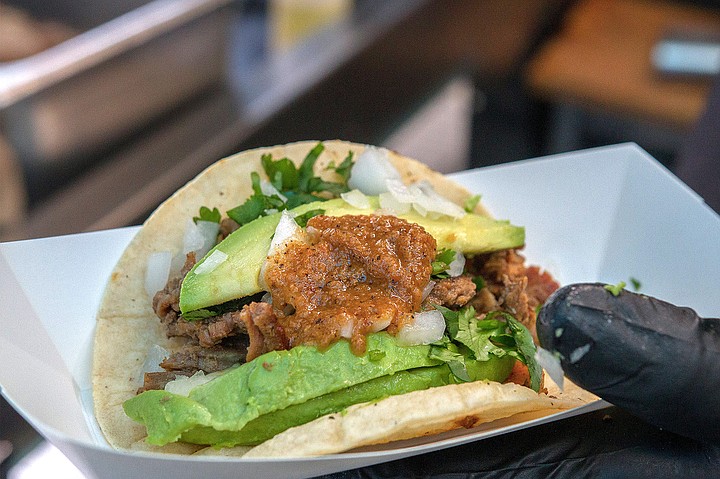
“Well, there’s money here now, Mexican money, a lot,” answered Bourdain. “Dandy del Sur, a go-to for locals. An institution for casual consumption of liquor. And mostly, almost entirely Mexican. This is a reputable establishment.” And it got a whole lot more reputable after it was visited by foodie royalty. A photo of Bourdain and Tony still hangs in Dandy del Sur, just to the side of the jukebox.
From there, the two slipped across the street to La Mezcalera, which Bourdain called a place for crazy young hipsters where he felt like someone’s creepy uncle Fred. The flight of mezcals and the chapulines in the bar put him in a fine mood, but it was soured when they left the bar to find a bright pink limousine awaiting them — a relic, a hangover from the stupid old gringo tourist days. Bourdain described it as “a kick in the nuts.” Even worse, the limousine wouldn’t start. (Today, that limousine is parked in the back patio of La Mezcalera; its roof has been removed and there is a table set in the middle. No sense in wasting good kitsch.)
Once they got the limousine going, Tony took Bourdain to Las Ahumaderas, also known as taco alley. On the way, he claimed that Tijuana had the best tacos in the country. Bourdain disputed the claim, with good reason. The tacos in taco alley are average at best, and Tony still gets criticized for his choice of taquerias. To a regular tourist, they can seem amazing. But Anthony Bourdain was not a regular tourist. Still, he seemed happy enough in taco alley, eating campechano tacos with chorizo and asada, and pastor tacos with plenty of guacamole, “I like taco alley,” said Bourdain as the screen fadesdto black. And a photo of Tony and Bourdain still hangs in the third taquería in taco alley.
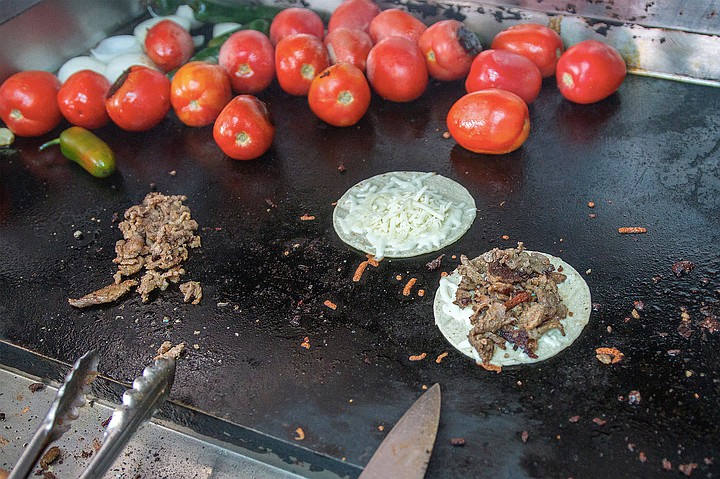
Tony’s role in the episode ends there, though deleted scenes can be found on the Travel Channel website. He also took Bourdain to see the greyhound dog racing in the Hipodromo Casino. It’s clear that the scene was deleted for good reason: Bourdain seemed uninterested in the tostilocos he was served, and disgusted rather than charmed by the idea that the dogs used to have monkeys riding them like jockeys.
Tony was chosen to serve as Bourdain’s Tijuana tour guide because Tony touts Tijuana tirelessly. The son of a Tijuana lawyer, he is himself a law graduate from Universidad de Monterey. But, he says, “at some point, even while still in law school, I knew I wouldn’t be a lawyer for a living.” The city offered too many intriguing alternatives. “I went from law school to becoming Tijuana’s most famed underground dance party promoter — from 2005 to 2010 and beyond. I was renting out old abandoned movie theaters to throw all-night dance parties, with DJs from all over the world. And at the same time, I was involved in politics,” stumping for independent mayoral candidate Gaston Luken. “Then I started promoting the Zonkeys basketball team around 2009.” His campaign work took him to San Diego and Hollywood; eventually, he found work as a fixer for international media, wrote for various reputable and not-so-reputable media outlets, got paid by the big beer companies to put on shows, briefly set up cannabis tours in San Diego, and generally promoted Tijuana events. All the while, he enjoyed the party lifestyle of a local celebrity.
And all the while, he dreamed of owning a restaurant. Originally, he says, “I wanted a restaurant under the Chiki Jai.” Chiki Jai is a Tijuana restaurant that has been open since 1947. It used to be situated on the corner of 7th and Avenida Revolución, but it moved across the street after a fire in 2018. Legend says that Ernest Hemingway used to have lunch at the original Chiki Jai with jai alai player José Garate, but there is no proof of this. At any rate, the site is now host to the newest and tallest building in downtown Tijuana; a generic coffee shop occupies the restaurant’s former spot. Before the fire, says Tony, “there was an old underground men’s club there called El Unicornio.”
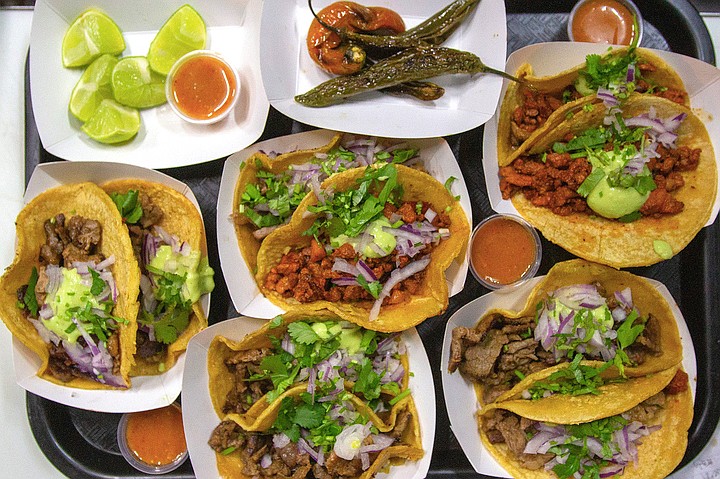
That was his dream spot. “But the idea mutated into a food truck in San Diego, at a muffler yard that my wife’s family owns. It was all I could afford. The truck cost around $50,000. It’s a 1997 GMC made by LA Catering. Pretty standard lunch truck from that era. I’m not sure how many previous owners it had before me, or how many different things got made in it. But many.” Corazón de Torta food truck opened on May 5th, 2017. Tony lived in Tijuana at the time, and crossed the border almost daily, riding the trolley to get his taco truck by the muffler shop near 25th Street and Commercial.
“The first year was a learning experience,” says Tony. “We got popular quickly, at least among some of the San Diego food people, taco lovers, and local media. All of that helped, but if making money in the food business was easy, everybody would do it. It’s been a lot of hard work.” Tony often posted stories on Instagram of his tired face riding the trolley back to Tijuana late at night.
Working the truck is a two-man job, and, he says, “I had to fire my first worker. He was pounding beers inside the muffler shop’s bathroom like some sort of crackhead. Luckily, I’ve had Mario from almost the beginning.” For most of Corazon de Torta’s history, it’s been Tony and Mario, the man who cooks while Tony mans the cash register, talks to customers, and promotes his food. “We got tacos, tortas, and quesadillas!” Tony will cry, anglicizing the “dillas” part of “quesadillas” when he tries to entice Americans. “Tortas, tacos y quesadillas con todo!” he shouts when Mexicans approach the truck.
However, Mario has a full-time job at a rental car company. He can work with Tony only on the weekends. That means Tony must recruit part-time help. A cross-border artist painted both the truck and the muffler yard, then worked the truck sporadically before deciding to live solely by her art. Damian, a psychedelic rock musician who looks like a cartoon version of the Ramones mixed with a space cowboy, worked at the truck for most of 2020. Now he works at the Levi’s Store in Plaza Las Americas while still playing shows. That first guy Tony fired (I won’t name him) is a musician and a rapper. He is a proud drunk who jumps from taco shop to taco shop, getting fired from each job for the same reason. DJs, models, photographers, writers, musicians, artists, and more folks who are between gigs have all ended up lending Tony a helping hand.
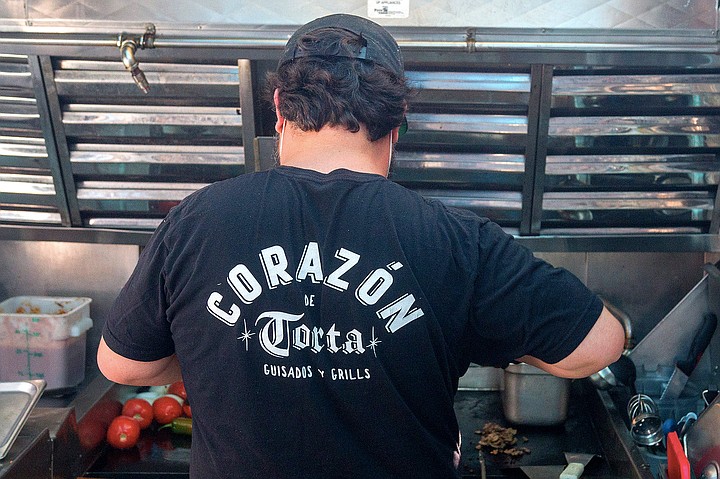
The first menu was made by Tijuana chef José Figueroa, aka Chef Joe. It included a meatball chipotle sub (the specialty torta), a dirty taco (filled with crispy cheese, carne asada, and chipotle ragu), varied guisados (beef short rib with salsa guajillo, chicharrón in salsa morita), and the vegan specialty roasted cauliflower with Oaxacan mole. “Cooking comes from the corazón,” says Tony. “Chef Joe learned from his grandmother Carmelita. Joe made one of the most authentic home cooking menus in San Diego of guisados for us.” Corazón de Torta’s slogan is Authentic Abuelita Cooking.
Chef Joe rose to fame with his own taco truck, “La Carmelita,” situated in Tijuana’s Teléfonica Gastro Park. It was once featured in the New York Times, in an article called 52 Places to Go in 2017. Tijuana came in at #8; Chef Joe’s food truck was a featured attraction. But his truck left the food court in 2021; now, Chef Joe plans to open a tortillería, restaurant, and hotel experience in Colonia Independencia. But he still helps Tony from time to time, improving his menu or helping him come up with specials for important events.
It’s those events that first enticed Tony to venture away from the muffler shop. “The first place that invited me was Por Vida Coffee shop on Logan; it was for a Wednesday Low Ride Cruise they do call La Vuelta,” recalls Tony. After that, the truck started getting invited to different breweries and farmer’s markets, to different neighborhoods, and to special events, like the Reader’s Tacotopia. “It got to the point where we sold more leaving the muffler shop than staying there, so we made the operation mobile” — that is, after all, the glory of a food truck. That was summer 2018; these days, instead of parking in the muffler yard, the truck spends its nights in a San Ysidro food truck parking lot.

Other changes: his longtime girlfriend gave birth to their daughter Frida in October of 2018. Now a family man, he moved in 2019 from an “old, big, and cold house” to a modern and more expensive apartment in Tijuana with excellent views. “But the place had its issues: lack of insulation made it cold, it had some major leaks when it rained, and we had perverted upstairs gringo neighbors that loved drugs and prostitution. Worst of it all, they were loud as fuck. Still, I threw some great parties in there.”
Until July, anyway. Diagnosed with diabetic ketoacidosis, “I stayed in the hospital for five nights. It changed many things about my lifestyle.” Life got serious: he stopped partying, changed his diet, and started playing tennis. The next year, he moved his family to Chula Vista. He had crossed the border daily for almost three years, but he couldn’t make the lifestyle work any more. “Ya tiré la toalla con TJ,” he says meaning he has given up on Tijuana. “Goodbye, international border commute! Goodbye, TJ traffic! Good riddance, TJ chaos! I moved my family to San Diego. Now I can just go there to eat tacos every now and then, or go to the baseball game with you, and then come back to San Diego.”
He landed in San Diego just as the pandemic was shutting things down. But luck was with him. Pandemic regulations required establishments that served alcohol to serve food as well. That meant breweries were eager for food trucks to post up outside. “We were posting up at Fall Brewing four times per week at one point,” he recalls. Besides the usual menu, Tony’s truck served $2 chips and salsa — technically, patrons were still getting food with their beer.
Post-pandemic, “I still go to a few breweries here and there, but luckily, Fall Brewing has been our weekend anchor for five years. They are family now.” Nowadays, it’s common to see Tony and his truck at Fall Brewery every weekend. On Wednesdays, he is usually outside Klover dispensary. Some Thursdays, he parks outside Pure Project in North Park. Caterings and special events take the truck everywhere else in San Diego. (The best way to find where the truck is going to be slinging tacos from is to follow them on Instagram: @corazondetortasd.)
I met Tony in 2014, during a music festival called the Tijuana Rumble Fest. I was one of the main organizers, and it was my job to take concertgoers from the border to the festival on a bus. It was a quarter past noon when Tony jumped on the bus and yelled, “Who is ready to do a shit ton of yayo?” The bus was mostly filled with Americans crossing the border for the first time, and it made for a memorable introduction to both the man and the city. Tony was only half kidding: that festival was a mess of art, noise, and drugs. Maybe that’s why doesn’t remember that meeting; he just remembers that our relationship grew through the comments in Tijuana threads online, through attending the same parties, through mutual friends, and through our shared love for Tijuana baseball.
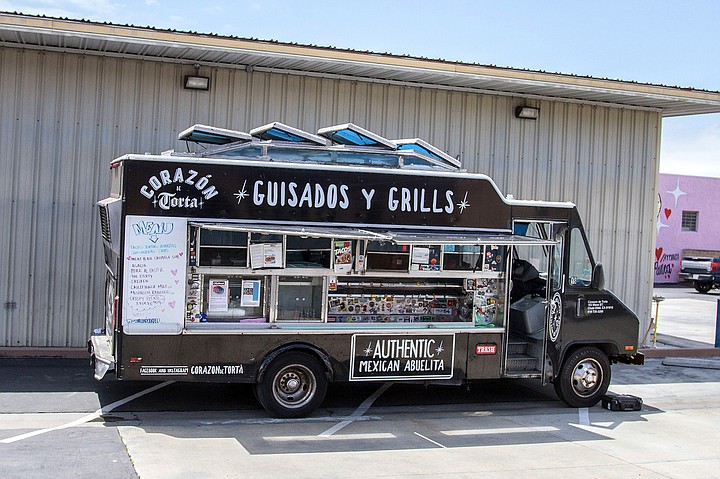
On September 2 of 2021, Tony texted me, “You wanna make 100 bucks tomorrow? I need a cashier, everybody canceled on me. Fall Brewing from 3 pm to 9 pm. Plus, I’ll give you some beers.” By then, he knew me well enough to entice me with beers. The next day was my first shift in a taco truck.
Working as a helping hand for Tony is a simple job. It’s mostly taking orders, charging the customers, and doing whatever Tony asks. DING DING! “Tacos for Josh, asada tacos for Josh,” I ring the bell and yell through the truck’s window. If the person doesn’t show up, I carry the tacos around, yelling their name. DING DING! “Chicken quesadilla for Peter! You want extra salsa with that? Potato tacos for Meghan, no guac! Tres de asada para Brian!”
“I had a catering event up in La Jolla, so I got the nice meat for asada this time,” Tony informs me. “I had to cook birria for a special event. Try it; I make it better than anyone in Tijuana. And there’s some leftover cauliflower mole from the festival, it’s still good. Prices went up again: it’s $5 a taco now, or three for $14.” The menu and prices change every time I go to work, but it usually includes three basics: tacos ($5), quesadillas ($14), and tortas ($14), with a choice of meats: chicken, beef, pork, or special of the week. There’s also usually a vegan choice: golden potato crispy tacos, mushroom birria, or the popular cauliflower mole. And weekly specials: beer battered fish, pork belly tacos, meatball chipotle torta, bluefin sopes, breakfast chilaquiles, vegan ceviche, or whatever chef Joe and Tony happen to create together.
“We only got, what, nine orders, and it’s almost rush hour?” he laments. “Time to entice them.” Tony tosses two or three sliced onions covered with oil on the grill and turns on the truck’s fan, sending the seductive smell of carmelizing onions in the direction of the beer drinkers. Then he collects the grilled onions and offers them to clients as freebies. Tony is a sloppy but generous cook. The tacos are small but packed with meat, sometimes more than necessary, like a pastrami sandwich from a New York deli. If he makes a mistake — something gets burnt, or a tortilla breaks — he tosses it in the direction of a box under the stove. But his aim isn’t great: it tends to go everywhere in the food truck, sometimes hitting me. “Don’t worry, it gets fully cleaned in San Ysidro,” says Tony as I pick up after his mess.
If we get more than 50 orders in a shift, Tony is happy, and shows off how much money the truck made that week or month. “I shouldn’t have called you, didn’t even need you,” he’ll say. If it’s slow, Tony gets stressed and tells me all about his money issues, how he overspent on Bad Bunny tickets, or how the truck needs repairs yet again. When Tony gets mad for my bad handwriting, for the lack of customers, or for other things for which I’m not at fault, I remind him that I would rather be his friend than his employee.
At the end of the shift, I do some light cleaning and menial tasks. Whichever brewery the truck is parked at usually offers us free beer. A mutual exchange: beertenders get free food and give generous tips. Food runners or chefs get free beer and give the same tips back. Most people in North Park are generous tippers. This time, I go home with $100 plus in tips and a four-pack of beer, just for hanging out for a while with my friend Tony while we work a food truck.
Anthony Bourdain once said, “Food is everything we are. It’s an extension of nationalist feeling, ethnic feeling, your personal history, your province, your region, your tribe, your grandma. It’s inseparable from those from the get-go.” In essence, the food truck is an extension of what Tony is: a loud cross-border entertainer with a passion for being a people pleaser, whether it’s through his jokes, his stories, or his food.


“I’m doing this guerrilla-style!” shouts Antonio Ley, also known as El Tony Tee, as I approach his taco truck. “We got kicked out because of the stupid bike lane last week, and I have to park here for now.” The stupid bike lane in question runs along 30th Street as it cuts through North Park, and its installation in February of 2022 cost the street nearly 400 parking spaces, including the one right in front of Fall Brewing, where Tony liked to park his taco truck, Corazón de Torta. So now he’s set up in a nearby residential spot. “The cop told me to move anywhere, just as long as I didn’t block the bike lane. And I know the girl who lives here. She’s celebrating her birthday in Valle de Guadalupe. I keep texting her, but no answer.” (Eventually, the brewery will have to sacrifice some patio space to accommodate visiting food trucks.)

I’m here because I work in Tony’s truck from time to time. He calls me whenever his main cook is on vacation, or when he is in between workers. If I’m not available, he has several friends in rotation. Sometimes, he ends up asking a family member to cover for him. But I try to be available.
When I work the truck, I do a bit of everything — from cleaning, to making salsa, to prep work, to cooking, to photographing the food for marketing purposes. Mostly, I man the cash register and take tacos to the customers. But even though I am the one in the window taking orders, most of the customers want to talk to Tony — and he is eager to talk back. Tony Tee is vociferous, and a natural entertainer, happy to talk to everyone and no one about everything and nothing. Today, he will tell every customer that same story about the stupid bike lane, asking if they are for or against the lane, and how many bikes they’ve seen go by. A while back, he told everyone that he had gotten tickets to the Bad Bunny concert. Why wouldn’t they want to know?
I’ve known Tony for nine years, but I knew of him years before that. Part of Tony’s celebrity is the sort that comes when you bump up against a superstar and get a little stardust rubbed off on yourself: when chef-turned-author-turned-food-adventurer Anthony Bourdain visited Tijuana in January 2012, Tony acted as one of his tour guides. “I didn’t know I was going to tour him until a few hours before!” says Tony when I ask him about it. “Yeah, people give me shit because of the places I took him, but I had no time to properly prepare.”
Bourdain visited Tijuana for Episode 9 of Season 8 of his Travel Channel show No Reservations. It aired on May 27, 2012. The episode started with Bourdain crossing the border and eating a basic torta at one of the stands near the old San Ysidro gateway. That was followed by a Baja-Med style meal of sous vide beef tongue served by Javier Plascencia in one of his restaurants, Mision 19. The restaurant celebrated its 12 anniversary in January 2023 — it was only a year old when Bourdain visited. Bourdain seemed delighted with every plate he sampled.
Later in the episode, Tony and Bourdain met on Calle Sexta near Avenida Revolución to check out Dandy del Sur. “Tijuana grew up as a reaction to Prohibition,” said Bourdain. “When you couldn’t get a drink in California, Americans came here, wanting gambling, horse racing, and hookers, along with their cocktails.”
Added Tony, “What Tijuana is slowly starting to realize is that the old concept of tourism here, a $10 all-you-can-drink, nasty bar full of Marines, is not going to fly anymore,” He took a drink from his beer and continued: “[Tijuana]is in its beginning phases of re-inventing itself. There’s avant-garde restaurants over here now; there’s tiny little dive bars. It’s not for the tourist, the Yankee gringo tourist we are all used to. It’s for the locals. It’s all local kids, having a great time.”

“Well, there’s money here now, Mexican money, a lot,” answered Bourdain. “Dandy del Sur, a go-to for locals. An institution for casual consumption of liquor. And mostly, almost entirely Mexican. This is a reputable establishment.” And it got a whole lot more reputable after it was visited by foodie royalty. A photo of Bourdain and Tony still hangs in Dandy del Sur, just to the side of the jukebox.
From there, the two slipped across the street to La Mezcalera, which Bourdain called a place for crazy young hipsters where he felt like someone’s creepy uncle Fred. The flight of mezcals and the chapulines in the bar put him in a fine mood, but it was soured when they left the bar to find a bright pink limousine awaiting them — a relic, a hangover from the stupid old gringo tourist days. Bourdain described it as “a kick in the nuts.” Even worse, the limousine wouldn’t start. (Today, that limousine is parked in the back patio of La Mezcalera; its roof has been removed and there is a table set in the middle. No sense in wasting good kitsch.)
Once they got the limousine going, Tony took Bourdain to Las Ahumaderas, also known as taco alley. On the way, he claimed that Tijuana had the best tacos in the country. Bourdain disputed the claim, with good reason. The tacos in taco alley are average at best, and Tony still gets criticized for his choice of taquerias. To a regular tourist, they can seem amazing. But Anthony Bourdain was not a regular tourist. Still, he seemed happy enough in taco alley, eating campechano tacos with chorizo and asada, and pastor tacos with plenty of guacamole, “I like taco alley,” said Bourdain as the screen fadesdto black. And a photo of Tony and Bourdain still hangs in the third taquería in taco alley.

Tony’s role in the episode ends there, though deleted scenes can be found on the Travel Channel website. He also took Bourdain to see the greyhound dog racing in the Hipodromo Casino. It’s clear that the scene was deleted for good reason: Bourdain seemed uninterested in the tostilocos he was served, and disgusted rather than charmed by the idea that the dogs used to have monkeys riding them like jockeys.
Tony was chosen to serve as Bourdain’s Tijuana tour guide because Tony touts Tijuana tirelessly. The son of a Tijuana lawyer, he is himself a law graduate from Universidad de Monterey. But, he says, “at some point, even while still in law school, I knew I wouldn’t be a lawyer for a living.” The city offered too many intriguing alternatives. “I went from law school to becoming Tijuana’s most famed underground dance party promoter — from 2005 to 2010 and beyond. I was renting out old abandoned movie theaters to throw all-night dance parties, with DJs from all over the world. And at the same time, I was involved in politics,” stumping for independent mayoral candidate Gaston Luken. “Then I started promoting the Zonkeys basketball team around 2009.” His campaign work took him to San Diego and Hollywood; eventually, he found work as a fixer for international media, wrote for various reputable and not-so-reputable media outlets, got paid by the big beer companies to put on shows, briefly set up cannabis tours in San Diego, and generally promoted Tijuana events. All the while, he enjoyed the party lifestyle of a local celebrity.
And all the while, he dreamed of owning a restaurant. Originally, he says, “I wanted a restaurant under the Chiki Jai.” Chiki Jai is a Tijuana restaurant that has been open since 1947. It used to be situated on the corner of 7th and Avenida Revolución, but it moved across the street after a fire in 2018. Legend says that Ernest Hemingway used to have lunch at the original Chiki Jai with jai alai player José Garate, but there is no proof of this. At any rate, the site is now host to the newest and tallest building in downtown Tijuana; a generic coffee shop occupies the restaurant’s former spot. Before the fire, says Tony, “there was an old underground men’s club there called El Unicornio.”

That was his dream spot. “But the idea mutated into a food truck in San Diego, at a muffler yard that my wife’s family owns. It was all I could afford. The truck cost around $50,000. It’s a 1997 GMC made by LA Catering. Pretty standard lunch truck from that era. I’m not sure how many previous owners it had before me, or how many different things got made in it. But many.” Corazón de Torta food truck opened on May 5th, 2017. Tony lived in Tijuana at the time, and crossed the border almost daily, riding the trolley to get his taco truck by the muffler shop near 25th Street and Commercial.
“The first year was a learning experience,” says Tony. “We got popular quickly, at least among some of the San Diego food people, taco lovers, and local media. All of that helped, but if making money in the food business was easy, everybody would do it. It’s been a lot of hard work.” Tony often posted stories on Instagram of his tired face riding the trolley back to Tijuana late at night.
Working the truck is a two-man job, and, he says, “I had to fire my first worker. He was pounding beers inside the muffler shop’s bathroom like some sort of crackhead. Luckily, I’ve had Mario from almost the beginning.” For most of Corazon de Torta’s history, it’s been Tony and Mario, the man who cooks while Tony mans the cash register, talks to customers, and promotes his food. “We got tacos, tortas, and quesadillas!” Tony will cry, anglicizing the “dillas” part of “quesadillas” when he tries to entice Americans. “Tortas, tacos y quesadillas con todo!” he shouts when Mexicans approach the truck.
However, Mario has a full-time job at a rental car company. He can work with Tony only on the weekends. That means Tony must recruit part-time help. A cross-border artist painted both the truck and the muffler yard, then worked the truck sporadically before deciding to live solely by her art. Damian, a psychedelic rock musician who looks like a cartoon version of the Ramones mixed with a space cowboy, worked at the truck for most of 2020. Now he works at the Levi’s Store in Plaza Las Americas while still playing shows. That first guy Tony fired (I won’t name him) is a musician and a rapper. He is a proud drunk who jumps from taco shop to taco shop, getting fired from each job for the same reason. DJs, models, photographers, writers, musicians, artists, and more folks who are between gigs have all ended up lending Tony a helping hand.

The first menu was made by Tijuana chef José Figueroa, aka Chef Joe. It included a meatball chipotle sub (the specialty torta), a dirty taco (filled with crispy cheese, carne asada, and chipotle ragu), varied guisados (beef short rib with salsa guajillo, chicharrón in salsa morita), and the vegan specialty roasted cauliflower with Oaxacan mole. “Cooking comes from the corazón,” says Tony. “Chef Joe learned from his grandmother Carmelita. Joe made one of the most authentic home cooking menus in San Diego of guisados for us.” Corazón de Torta’s slogan is Authentic Abuelita Cooking.
Chef Joe rose to fame with his own taco truck, “La Carmelita,” situated in Tijuana’s Teléfonica Gastro Park. It was once featured in the New York Times, in an article called 52 Places to Go in 2017. Tijuana came in at #8; Chef Joe’s food truck was a featured attraction. But his truck left the food court in 2021; now, Chef Joe plans to open a tortillería, restaurant, and hotel experience in Colonia Independencia. But he still helps Tony from time to time, improving his menu or helping him come up with specials for important events.
It’s those events that first enticed Tony to venture away from the muffler shop. “The first place that invited me was Por Vida Coffee shop on Logan; it was for a Wednesday Low Ride Cruise they do call La Vuelta,” recalls Tony. After that, the truck started getting invited to different breweries and farmer’s markets, to different neighborhoods, and to special events, like the Reader’s Tacotopia. “It got to the point where we sold more leaving the muffler shop than staying there, so we made the operation mobile” — that is, after all, the glory of a food truck. That was summer 2018; these days, instead of parking in the muffler yard, the truck spends its nights in a San Ysidro food truck parking lot.

Other changes: his longtime girlfriend gave birth to their daughter Frida in October of 2018. Now a family man, he moved in 2019 from an “old, big, and cold house” to a modern and more expensive apartment in Tijuana with excellent views. “But the place had its issues: lack of insulation made it cold, it had some major leaks when it rained, and we had perverted upstairs gringo neighbors that loved drugs and prostitution. Worst of it all, they were loud as fuck. Still, I threw some great parties in there.”
Until July, anyway. Diagnosed with diabetic ketoacidosis, “I stayed in the hospital for five nights. It changed many things about my lifestyle.” Life got serious: he stopped partying, changed his diet, and started playing tennis. The next year, he moved his family to Chula Vista. He had crossed the border daily for almost three years, but he couldn’t make the lifestyle work any more. “Ya tiré la toalla con TJ,” he says meaning he has given up on Tijuana. “Goodbye, international border commute! Goodbye, TJ traffic! Good riddance, TJ chaos! I moved my family to San Diego. Now I can just go there to eat tacos every now and then, or go to the baseball game with you, and then come back to San Diego.”
He landed in San Diego just as the pandemic was shutting things down. But luck was with him. Pandemic regulations required establishments that served alcohol to serve food as well. That meant breweries were eager for food trucks to post up outside. “We were posting up at Fall Brewing four times per week at one point,” he recalls. Besides the usual menu, Tony’s truck served $2 chips and salsa — technically, patrons were still getting food with their beer.
Post-pandemic, “I still go to a few breweries here and there, but luckily, Fall Brewing has been our weekend anchor for five years. They are family now.” Nowadays, it’s common to see Tony and his truck at Fall Brewery every weekend. On Wednesdays, he is usually outside Klover dispensary. Some Thursdays, he parks outside Pure Project in North Park. Caterings and special events take the truck everywhere else in San Diego. (The best way to find where the truck is going to be slinging tacos from is to follow them on Instagram: @corazondetortasd.)
I met Tony in 2014, during a music festival called the Tijuana Rumble Fest. I was one of the main organizers, and it was my job to take concertgoers from the border to the festival on a bus. It was a quarter past noon when Tony jumped on the bus and yelled, “Who is ready to do a shit ton of yayo?” The bus was mostly filled with Americans crossing the border for the first time, and it made for a memorable introduction to both the man and the city. Tony was only half kidding: that festival was a mess of art, noise, and drugs. Maybe that’s why doesn’t remember that meeting; he just remembers that our relationship grew through the comments in Tijuana threads online, through attending the same parties, through mutual friends, and through our shared love for Tijuana baseball.

On September 2 of 2021, Tony texted me, “You wanna make 100 bucks tomorrow? I need a cashier, everybody canceled on me. Fall Brewing from 3 pm to 9 pm. Plus, I’ll give you some beers.” By then, he knew me well enough to entice me with beers. The next day was my first shift in a taco truck.
Working as a helping hand for Tony is a simple job. It’s mostly taking orders, charging the customers, and doing whatever Tony asks. DING DING! “Tacos for Josh, asada tacos for Josh,” I ring the bell and yell through the truck’s window. If the person doesn’t show up, I carry the tacos around, yelling their name. DING DING! “Chicken quesadilla for Peter! You want extra salsa with that? Potato tacos for Meghan, no guac! Tres de asada para Brian!”
“I had a catering event up in La Jolla, so I got the nice meat for asada this time,” Tony informs me. “I had to cook birria for a special event. Try it; I make it better than anyone in Tijuana. And there’s some leftover cauliflower mole from the festival, it’s still good. Prices went up again: it’s $5 a taco now, or three for $14.” The menu and prices change every time I go to work, but it usually includes three basics: tacos ($5), quesadillas ($14), and tortas ($14), with a choice of meats: chicken, beef, pork, or special of the week. There’s also usually a vegan choice: golden potato crispy tacos, mushroom birria, or the popular cauliflower mole. And weekly specials: beer battered fish, pork belly tacos, meatball chipotle torta, bluefin sopes, breakfast chilaquiles, vegan ceviche, or whatever chef Joe and Tony happen to create together.
“We only got, what, nine orders, and it’s almost rush hour?” he laments. “Time to entice them.” Tony tosses two or three sliced onions covered with oil on the grill and turns on the truck’s fan, sending the seductive smell of carmelizing onions in the direction of the beer drinkers. Then he collects the grilled onions and offers them to clients as freebies. Tony is a sloppy but generous cook. The tacos are small but packed with meat, sometimes more than necessary, like a pastrami sandwich from a New York deli. If he makes a mistake — something gets burnt, or a tortilla breaks — he tosses it in the direction of a box under the stove. But his aim isn’t great: it tends to go everywhere in the food truck, sometimes hitting me. “Don’t worry, it gets fully cleaned in San Ysidro,” says Tony as I pick up after his mess.
If we get more than 50 orders in a shift, Tony is happy, and shows off how much money the truck made that week or month. “I shouldn’t have called you, didn’t even need you,” he’ll say. If it’s slow, Tony gets stressed and tells me all about his money issues, how he overspent on Bad Bunny tickets, or how the truck needs repairs yet again. When Tony gets mad for my bad handwriting, for the lack of customers, or for other things for which I’m not at fault, I remind him that I would rather be his friend than his employee.
At the end of the shift, I do some light cleaning and menial tasks. Whichever brewery the truck is parked at usually offers us free beer. A mutual exchange: beertenders get free food and give generous tips. Food runners or chefs get free beer and give the same tips back. Most people in North Park are generous tippers. This time, I go home with $100 plus in tips and a four-pack of beer, just for hanging out for a while with my friend Tony while we work a food truck.
Anthony Bourdain once said, “Food is everything we are. It’s an extension of nationalist feeling, ethnic feeling, your personal history, your province, your region, your tribe, your grandma. It’s inseparable from those from the get-go.” In essence, the food truck is an extension of what Tony is: a loud cross-border entertainer with a passion for being a people pleaser, whether it’s through his jokes, his stories, or his food.
Comments